Roma antica foro romano colosseo altare della patria circo massimo roma virtuale 3d lazio
chiese-eng
inglese



Churches and Basilicas
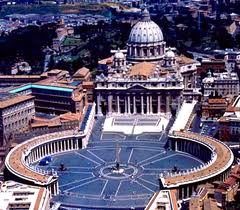 The original Basilica was built in the first half of the 300’s under Silvestro I pontificate, torn down in 1506 and replaced by the existing building. Pope Giulio II hired the architect Bramante to oversee works and the most famous architects of the time argued over the project during the years. Among these Michelangelo, Peruzzi e Bramante decided to use the Greek cross plan while Raphael Sanzio and Sangallo decided to transform the Greek cross design with a Latin cross-like structure. The basilica was defined by Carlo Maderno in the first years of 1600, during the pontificate of Paolo V who imposed to reuse the Latin cross-like structure. The Great Steps and the colonnade in Saint Peter’s Square was planned and completed by Bernini replanned the baldachin and decorated the papal altar. The Dome was planned by Michelangelo who never saw it complete It was later finished by Fontana and Della Porta. The facade erected by Carlo Maderno, supported with highly prominent columns, is 115 mt wide and more than 40 metres high and the massive statues of St. Peter and St.Paolo stand out of it. The new basilica has maintained the original structure with one nave and four aisles. It is 131.66 metres (432.0 ft) long, 65 metres (213 ft)-wide, and 29.70 metres (97.4 ft)-high, the second largest in Rome.
The original Basilica was built in the first half of the 300’s under Silvestro I pontificate, torn down in 1506 and replaced by the existing building. Pope Giulio II hired the architect Bramante to oversee works and the most famous architects of the time argued over the project during the years. Among these Michelangelo, Peruzzi e Bramante decided to use the Greek cross plan while Raphael Sanzio and Sangallo decided to transform the Greek cross design with a Latin cross-like structure. The basilica was defined by Carlo Maderno in the first years of 1600, during the pontificate of Paolo V who imposed to reuse the Latin cross-like structure. The Great Steps and the colonnade in Saint Peter’s Square was planned and completed by Bernini replanned the baldachin and decorated the papal altar. The Dome was planned by Michelangelo who never saw it complete It was later finished by Fontana and Della Porta. The facade erected by Carlo Maderno, supported with highly prominent columns, is 115 mt wide and more than 40 metres high and the massive statues of St. Peter and St.Paolo stand out of it. The new basilica has maintained the original structure with one nave and four aisles. It is 131.66 metres (432.0 ft) long, 65 metres (213 ft)-wide, and 29.70 metres (97.4 ft)-high, the second largest in Rome.
San Giovanni in Laterano (St. John)
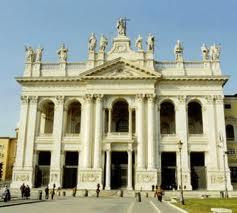
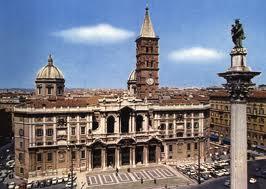
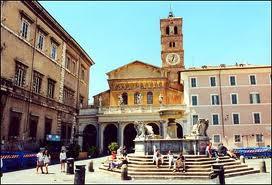
San Paolo fuori le mura (Saint Paul outside the walls)
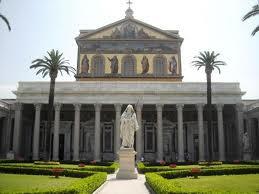
It was built over the burial place of Saint Paul, 3km far from Three Fountains area, where the Apostolus was beheaded and martyrised. After various structural renovation, the saint’s sepolcrum is today located under the Great Altar . The Basilica of Saint Paul Outside the Walls today has been included in the jubilee itinerary since 1300 AD and as a pilgrim destination. The basilica was extensively modified and redecorated over the centuries. The inner structure has 80 columns separating the 5 naves and a precious coffered ceiling. Each pope has his mosaic portrayed in a frieze. The external portico, gathering the garden is made of 150 columns and is an addiction of 1928. The cloister, instead, is a masterpiece of twelfth century and saves various architectural fragments of the original building
Basilica di Santa Maria in Ara Coeli
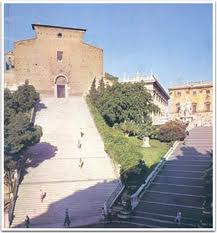 The Basilica of St. Mary on the Altar of Heaven, on the highest summit of the Capitol Hill, is named after a vision of the Emperor August, where a beautiful lady, the Virgin Mary, with baby in her breast said to him ‘ this is the God’s son Altar’ . Unfortunately, this church lived hard times. As it was considered the Church of people, it was turned into a stable in 1797, during the napoleonic invasion, while after Italy United things went worse and was designated to Municipal Police. The interior has three pointed naves separated by twenty-two columns, and it’s full of artistic treasures: remarkable are the rich coffered ceiling, the precious pavement, Bufalini Chapel, frescoed by Pinturicchio and the tombstone of Giovanni Crivelli by Donatello. The Church saves a copy of the wooden statue of Infant Jesus. The original carved in olive tree of Getsemani, has been stolen in 1994 and never recovered.
The Basilica of St. Mary on the Altar of Heaven, on the highest summit of the Capitol Hill, is named after a vision of the Emperor August, where a beautiful lady, the Virgin Mary, with baby in her breast said to him ‘ this is the God’s son Altar’ . Unfortunately, this church lived hard times. As it was considered the Church of people, it was turned into a stable in 1797, during the napoleonic invasion, while after Italy United things went worse and was designated to Municipal Police. The interior has three pointed naves separated by twenty-two columns, and it’s full of artistic treasures: remarkable are the rich coffered ceiling, the precious pavement, Bufalini Chapel, frescoed by Pinturicchio and the tombstone of Giovanni Crivelli by Donatello. The Church saves a copy of the wooden statue of Infant Jesus. The original carved in olive tree of Getsemani, has been stolen in 1994 and never recovered.
Basilica di Santa Maria del Popolo
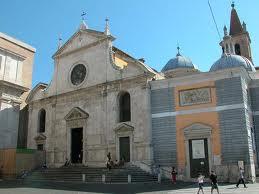
The Crucifixion of St. Peter and the Conversion of St. Paul by Michelangelo Merisi alias Caravaggio, are also two wonderful paintings in this Church one cannot miss. Depicted between 1600 and 1601, they feature the Michelangelo painting themes in the Vatican Paoline Chapel but are different in expressive language. They represent the dramatic human reality by a contrasting game of lights and shadows that hide and enhance the characters depicted. The Augustinian cloister, then, was Martin Luther’s temporary site in Italy in his early years.
Church of Saint Ignatius Loyola
It was built in 1626 in “Latin Cross” plan. It was dedicated to the order and to the founder of Jesuits
Recent studies have ascertained that it is Orazio Grassi’s project. He was architect, mathematician and astronomer, and antagonist of Galileo Galilei.
It was rich in works of great artists such as Andea Pozzo, Francesco Trevignani, Filippo della Valle, it shows exceptional pictorial perspectives, over 6 chapels situated along the side aisles and finally the beautiful tomb of Gregory XV.
A wonderful testimony of the religious history of Rome, the Church is in Baroque style like many other churches in Rome, but its peculiarity is in its foundations.
In 1853 the original Church was brought to light. It was situated under the current building, of the period of Constantine I, interesting frescoes were brought to light.
An exceptional discovery was made, the original church had been built on a structure of the imperial period, and inside there was a well-preserved Mithraeum.
San Lorenzo fuori le mura (St. Lawrence Outside the Walls)
It’s made up by the merge of two neighboring churches. The first built in 330s by Constantine over the the tomb of St. Lawrence, deacon martyr, the second erected in 580s by Sixtus III in honour of the Virgin Mary and entirely rebuilt by Hadrian I. It was severely damaged in the bombing on 19th July 1943, and restored for the Jubilee in 1950.
San Sebastiano fuori le mura (St Sebastian Outside the Walls)
It’s also known as Basilica Apostolorum as initially dedicated to the Apostles Peter and Paul, whose remains were kept in the catacombs below. Subsequently it was buried St. Sebastian, victim of Diocletian persecution.
Santa Croce in Gerusalemme (Holy Cross in Jerusalem)
According to the tradition, the building, erected on the site o fan imperial palace, was committed by the emperor Constantine in 330’s to keep the relics of the Holy Cross brought to Rome by his mother Helen from the Holy Land and as thanksgiving gift to the cross that appared to him in prediction of his victory over Maxentius.
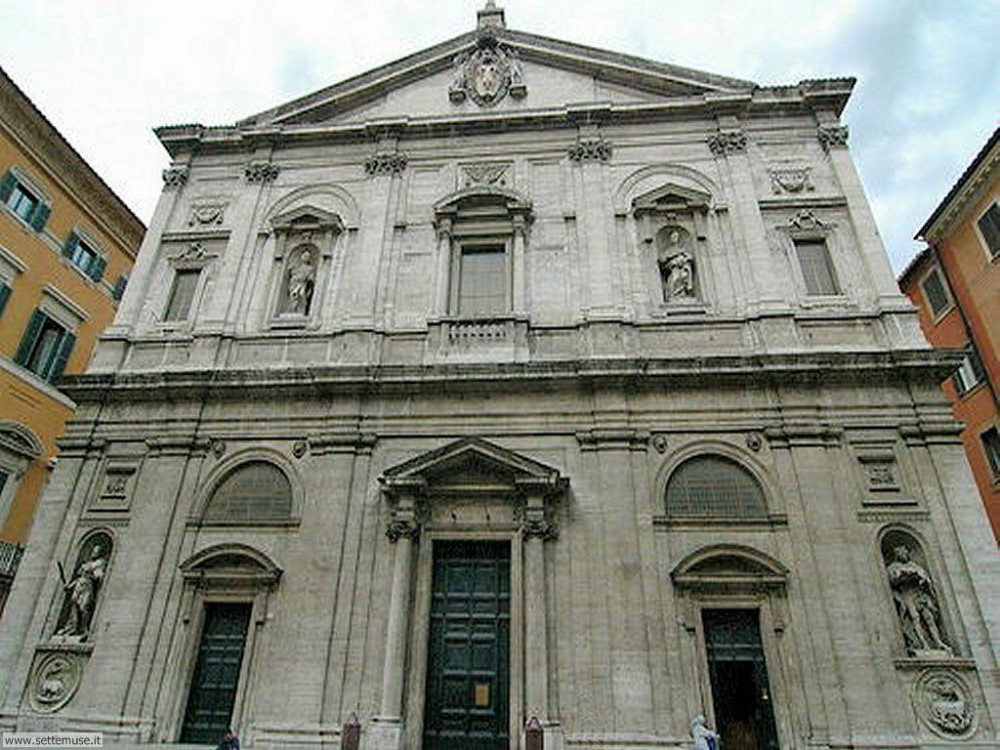 Church of St. Louis of the French
Church of St. Louis of the French
It officially is the national church of the French in Rome, started in 1518 but finished in 1589 by Domenico Fontana, the original project was by Giacomo della Porta. Most of the funds for the construction of the church were donated by queen Catherine De Medici. In front there are the statues of the French “Glories”, Charles the Great, St. Louis, Saint Clotilde and St. John of Valois. The church is famous around the world for the masterpieces by Caravaggio in its Contarelli chapel.
Located in Via Porta San Sebastiano 7, within the Ancient Appia Park. Discovered in 1875 in a farmhouse used as a cheese warehouse at the time. Even though it was dedicated to Archangel Gabriel, the oratory is known as of the Seven Sleepers, the martyrs of Ephesus of the III century who according to the legend were walled-in alive in a cave but were found two centuries later still living and asleep. They had such popularity that in the XVIII century Clement XI had the oratory restored and promised its veneration. The inside is accessible from a door surmounted by an architrave on which equilateral crosses are sculpted.
Church “Santa Maria della Pace”
It was built in the place of the medieval chapel of Saint Andrew de Acquaricariis at the end of the XV century, it was restored in 1656 through the creation of the wonderful convex façade by Pietro da Cortona. Its semicircular pronaos, is a masterpiece of the Roman baroque architecture .
Inside we can see the frescoes by Raphael such as “sybils and angels”(1514), and the altar by Carlo Maderno, the stuccos and the wonderful cloister by Bramante (1500-1504), one of the most important works during the Renaissance of the XVI century.
It’s a square-plan building, the effect is obtained through a module, the central space is surrounded by 16 pillars.
The Basilica was built in the IX century on the foundations, of Saint Caecilia’s house. It was later developed with the tower bell, the right side and the cloister.
In front of the Church with baroque façade, there is a colonnade of the XVIII century, the original colonnade is today a beautiful garden with a great Roman pot in the middle.
But in the basement of the church the "calidarium", that is the place where the martyr (S. Caecilia), had suffered for three years the torture, and where her persecutors beheaded her, not stifled by the hot fumes yet, on wish of emperor Marcus Aurelius, after the third day, because she was guilty, of having tried to convert Valeriano and his brother Tiburzio.
The body of the saint had been found for much time, it was brought to light in 820 in the catacombs of Saint Callixtus, miraculously uninjured and wrapped in a dress. Today the body is situated in the crypt of the basilica.
Piazza Foro Traiano and Piazza della madonna di Loreto
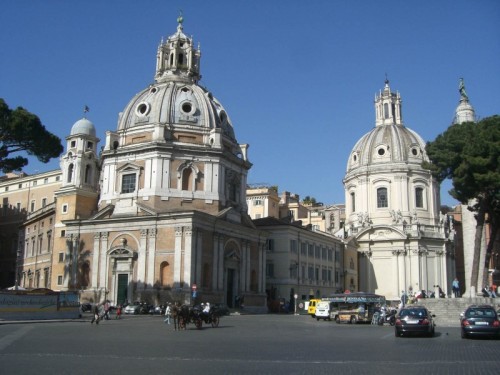 They are situated near place Venezia, in the direction of via dei fori imperiali. One of the most suggestive place of Rome, you must not miss it, you must photograph it !. In front of it, there are two churches, Santissimo Nome di Maria (Holy Name of Mary) (1736), which was built by Antoine Dérizet and then (in 1743) Mauro Fontana and Agostino Masucci, decorated the inner side. Nearby there is Santa Maria di Loreto (Saint Mary of Loreto), commissioned by Pope Alexander VI to replace a previous little chapel. He entrusted to Antonio da Sangallo the Young the works (in 1507). The dome and the lantern (surnamed the "Cricket’s cage”) was realized later by Giacomo Del Duca (in 1582), disciple of Michelangelo. The church is built with bricks and travertine, and it is very beautiful for its dimensions and the effect produced. But you need to walk on the place to see another period , beginning from Trajan’s column (113 a..C ), about 30 metres high and a base 40 metres high, built to celebrate the victory against the Dacians. The military campaigns are engraved and counted all over the column, but if you observe it, you realize that you are in another period, in the background there is the coliseum.
They are situated near place Venezia, in the direction of via dei fori imperiali. One of the most suggestive place of Rome, you must not miss it, you must photograph it !. In front of it, there are two churches, Santissimo Nome di Maria (Holy Name of Mary) (1736), which was built by Antoine Dérizet and then (in 1743) Mauro Fontana and Agostino Masucci, decorated the inner side. Nearby there is Santa Maria di Loreto (Saint Mary of Loreto), commissioned by Pope Alexander VI to replace a previous little chapel. He entrusted to Antonio da Sangallo the Young the works (in 1507). The dome and the lantern (surnamed the "Cricket’s cage”) was realized later by Giacomo Del Duca (in 1582), disciple of Michelangelo. The church is built with bricks and travertine, and it is very beautiful for its dimensions and the effect produced. But you need to walk on the place to see another period , beginning from Trajan’s column (113 a..C ), about 30 metres high and a base 40 metres high, built to celebrate the victory against the Dacians. The military campaigns are engraved and counted all over the column, but if you observe it, you realize that you are in another period, in the background there is the coliseum.
It is also known as “Tempio Maggiore”. It is one of the great synagogues of Europe. It is situated exactly at Piazza delle Cinque Scole, near the Tiber. The building and position were chosen by Victor Emmanuel II (after the Italian Unification in1870), granting citizenship to Italian Jews and the permit of rebuilding the Ghetto of Rome, but with the establishment to the Jews of 2 main conditions. First, the place, obtained from an area situated between two symbols of the “recognized Roman freedom”, the Capitol (with the monument to Victor Emmanuel II), and the Janiculum, a place of bloody wars of Risorgimento (with the statue of Garibaldi). The second condition concerned the dimensions of the building. The style of the building is assyro-babylonian, the dome is decorated with oriental motives. It’s a very important place for the Roman Jews, it is used as a prayer place and as a cultural reference. It is made up of two floors, one is underground, where is situated the Jewish Museum and a Little Synagogue (called Tempio Spagnolo) furnished with parts of the five “scole” (schools), as a tribute to the 5 synagogues, which were in times past in the ghetto (Castilian, Catalan, Sicilian, Nova, and Italian), this promoted the introduction in the rites of the people coming from different places. On the ground floor the “Great Synagogue”, it is a great room, divided by side naves. After the attack of 9 October 1982, by a Palestinian commando, which caused the death of a child who was 2 years old, and the wounding of 37 people, it is controlled 24 hours over 24, but is possible to visit it from Sunday to Thursday.
It was one of the biggest of Europe, inaugurated in 1995, considered by Muslims as the most prestigious Islamic centre of Italy. The believers go there to pray, or to hear the sermons of IMAM, and to celebrate the wedding according the Islamic rite. It was built with the projects of Portoghesi, Gigliotti and Moussawi. It is situated on the slopes of the Parioli Mountains, and it is well integrated with the surrounding vegetation (even if the whole area covers about circa 30.000 m²). Its inner part is in harmony with the environment too, it is characterized by a great room looking like a forest, with three-stems columns, like the trees.
